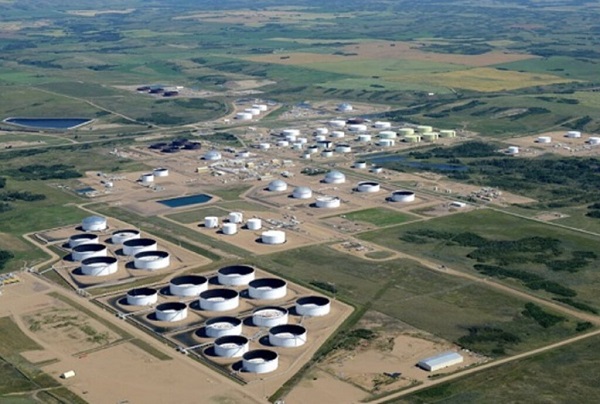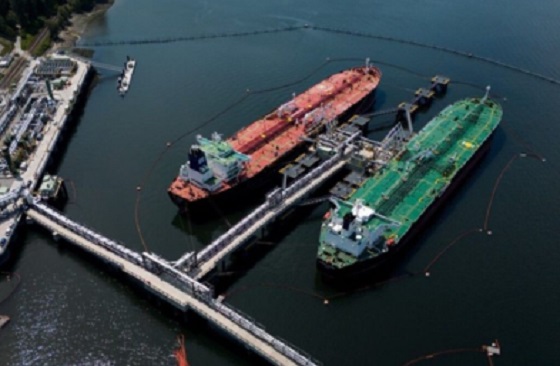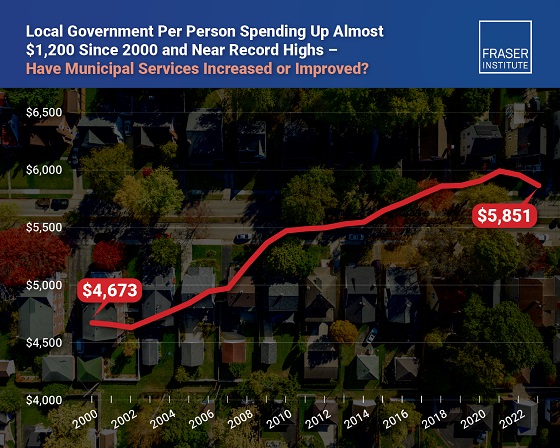Energy
Oil tankers in Vancouver are loading plenty, but they can load even more

From Resource Works
Despite years of protest, ballooning costs, and political hurdles, the federally funded TMX pipeline expansion has become a strategic economic success story for Canada.
The federally funded expansion of the Trans Mountain oil pipeline from Alberta to tidewater at Burnaby has been much attacked by critics, but has quickly turned into a gold-star success story.
The 980-km expansion, known as TMX, opened in May 2024, almost tripling the capacity of the original (1953) Trans Mountain Pipeline. Since then, TMX has enabled major expansion of our crude oil exports to American and Asian buyers.
It is, says Trans Mountain CEO Mark Maki, “one of the most strategic investments Canada has ever made,” providing Canada with new trading options to Pacific Rim nations in the face of Donald Trump’s tariffs, and bringing in billions in new revenues.
Since opening on May 1, 2024, Trans Mountain has sent half of its tanker shipments to countries other than the US, and half to refineries on the US west coast.
Alberta Central chief economist Charles St-Arnaud said in a report earlier this year that TMX had brought in an extra $10 billion in revenues in 2024, equivalent to “adding a thirteenth month of production to the year.”
The export picture would be even brighter if the Port of Vancouver could accommodate larger loads in departing oil tankers, and that now is being addressed by both federal and provincial governments.
Right now, 245-metre-long Aframax-size tankers can handle up to 120,000 tonnes of oil. But under our port restrictions and limited depths of water in Burrard Inlet, they usually load only up to 96,000 tonnes.
In the BC legislature, Gavin Dew, Conservative MLA for Kelowna-Mission and the Opposition critic for jobs, economic development and innovation, asked if BC and the new federal government are indeed supporting dredging Burrard Inlet to allow fully laden Aframax oil tankers.
The simple reply from Adrian Dix, BC’s minister of energy and climate solutions: “Yes.”
Dix added later in an interview that the idea most recently came from Prime Minister Mark Carney. “Broadly, the premier and us have indicated our support for it,” Dix said.
No plan or timing has yet been announced.
While fully loaded Aframax tankers would carry more oil, they still have to meet requirements that include these: All tankers calling at the Westridge Marine Terminal must first be pre-screened by Trans Mountain to ensure criteria are met for safety and reliability; They must be double-hulled, and have segregated internal cargo tanks; They must have two radar systems in working order, one of them being a specialized collision-avoidance radar. For loading, a containment boom is deployed to enclose the tanker and its berth while loading. The tankers are escorted by tugs, and carry a fully qualified and licensed marine pilot.
There are also upgraded emergency facilities to cope with any spill, but Trans Mountain notes that there has not been a single oil spill from one of its tankers since the original pipeline opened in 1956.
The terminal now can handle some 34 tankers a month.
While a success story now, the TMX expansion went through a lot of pain, protest, obstruction, money, and red tape to get there.
The expansion was first proposed in 2012 by the Canadian division of US pipeline giant Kinder Morgan Inc., which bought the original Trans Mountain pipeline in 2005. It applied in December 2013 for federal approval of expansion, and estimated the cost at $5.4 billion.
The expansion proposal then ran into endless protests, opposition from the BC government (then-premier John Horgan promised to use “every tool in the toolbox” to stop the expansion), and a federal approval process that took almost three years of red tape.
Ottawa’s approval finally came with 157 conditions, and BC’s “toolbox” now included restrictions on any increase in diluted bitumen shipments pending further studies.
By 2018, Kinder Morgan Canada said estimated costs had risen to $7.4 billion, and the company began to send up distress signals.
Ottawa then bought TMX from Kinder Morgan for $4.5 billion, calling the purchase “a serious and necessary investment made in the national interest.”
The feds added: “The completion of this important infrastructure project is making Canada and the Canadian economy more resilient by diversifying global market access for our resources.”
Construction began in the Edmonton area in November 2019. By 2020, though, Trans Mountain said the cost of the expansion had risen to $12.6 billion, and in 2022 the cost was estimated at $21.4 billion, the impact of the COVID-19 pandemic among the reasons. In March 2023, Trans Mountain put the cost at $30.9 billion.
Some of the benefits listed by Ottawa: Opening new markets for Canadian energy exports, reducing our reliance on a single customer, and ensuring that Canada receives fair market value for its resources while maintaining the highest environmental standards; Significantly increasing the royalties and tax revenues that all levels of government receive: According to an independent study, TMX is expected to add $9.2 billion in GDP and $2.8 billion in tax revenues between 2024 and 2043; Contributing to global and regional energy security by providing a secure, long-term supply of energy; Creating economic benefits for many Indigenous groups through contracting, financial compensation, and employment and training opportunities.
But Ottawa has said all along that it would not own the pipeline forever, and that at some point it will divest itself of ownership, and make at least partial ownership available to Indigenous groups.
Trans Mountain CEO Mark Maki now wonders if the feds might postpone that divestment, particularly if they decide TMX shouldn’t be the last oil export pipeline built in Canada.
We await word from the new federal government on its plans.
Alberta
Pierre Poilievre – Per Capita, Hardisty, Alberta Is the Most Important Little Town In Canada

From Pierre Poilievre
Energy
If Canada Wants to be the World’s Energy Partner, We Need to Act Like It

Photo by David Bloom / Postmedia file
From Energy Now
By Gary Mar
With the Trans Mountain Expansion online, we have new access to Pacific markets and Asia has responded, with China now a top buyer of Canadian crude.
The world is short on reliable energy and long on instability. Tankers edge through choke points like the Strait of Hormuz. Wars threaten pipelines and power grids. Markets flinch with every headline. As authoritarian regimes rattle sabres and weaponize supply chains, the global appetite for energy from stable, democratic, responsible producers has never been greater.
Canada checks every box: vast reserves, rigorous environmental standards, rule of law and a commitment to Indigenous partnership. We should be leading the race, but instead we’ve effectively tied our own shoelaces together.
In 2024, Canada set new records for oil production and exports. Alberta alone pumped nearly 1.5 billion barrels, a 4.5 per cent increase over 2023. With the Trans Mountain Expansion (TMX) online, we have new access to Pacific markets and Asia has responded, with China now a top buyer of Canadian crude.
The bad news is that we’re limiting where energy can leave the country. Bill C-48, the so-called tanker ban, prohibits tankers carrying over 12,500 tons of crude oil from stopping or unloading crude at ports or marine installations along B.C.’s northern coast. That includes Kitimat and Prince Rupert, two ports with strategic access to Indo-Pacific markets. Yes, we must do all we can to mitigate risks to Canada’s coastlines, but this should be balanced against a need to reduce our reliance on trade with the U.S. and increase our access to global markets.
Add to that the Impact Assessment Act (IAA) which was designed in part to shorten approval times and add certainty about how long the process would take. It has not had that effect and it’s scaring off investment. Business confidence in Canada has dropped to pandemic-era lows, due in part to unpredictable rules.
At a time when Canada is facing a modest recession and needs to attract private capital, we’ve made building trade infrastructure feel like trying to drive a snowplow through molasses.
What’s needed isn’t revolutionary, just practical. A start would be to maximize the amount of crude transported through the Trans Mountain Expansion pipeline, which ran at 77 per cent capacity in 2024. Under-utilization is attributed to a variety of factors, one of which is higher tolls being charged to producers.
Canada also needs to overhaul the IAA and create a review system that’s fast, clear and focused on accountability, not red tape. Investors need to know where the goalposts are. And, while we are making recommendations, strategic ports like Prince Rupert should be able to participate in global energy trade under the same high safety standards used elsewhere in Canada.
Canada needs a national approach to energy exporting. A 10-year projects and partnerships plan would give governments, Indigenous nations and industry a common direction. This could be coupled with the development of a category of “strategic export infrastructure” to prioritize trade-enabling projects and move them through approvals faster.
Of course, none of this can take place without bringing Indigenous partners into the planning process. A dedicated federal mechanism should be put in place to streamline and strengthen Indigenous consultation for major trade infrastructure, ensuring the process is both faster and fairer and that Indigenous equity options are built in from the start.
None of this is about blocking the energy transition. It’s about bridging it. Until we invent, build and scale the clean technologies of tomorrow, responsibly produced oil and gas will remain part of the mix. The only question is who will supply it.
Canada is the most stable of the world’s top oil producers, but we are a puzzle to the rest of the world, which doesn’t understand why we can’t get more of our oil and natural gas to market. In recent years, Norway and the U.S. have increased crude oil production. Notably, the U.S. also increased its natural gas exports through the construction of new LNG export terminals, which have helped supply European allies seeking to reduce their reliance on Russian natural gas.
Canada could be the bridge between demand and security, but if we want to be the world’s go-to energy partner, we need to act like it. That means building faster, regulating smarter and treating trade infrastructure like the strategic asset it is.
The world is watching. The opportunity is now. Let’s not waste it.
Gary Mar is president and CEO of the Canada West Foundation
-

 Business2 days ago
Business2 days agoOttawa Funded the China Ferry Deal—Then Pretended to Oppose It
-

 COVID-192 days ago
COVID-192 days agoNew Peer-Reviewed Study Affirms COVID Vaccines Reduce Fertility
-

 MAiD2 days ago
MAiD2 days agoCanada’s euthanasia regime is not health care, but a death machine for the unwanted
-

 Business1 day ago
Business1 day agoWorld Economic Forum Aims to Repair Relations with Schwab
-

 Alberta2 days ago
Alberta2 days agoThe permanent CO2 storage site at the end of the Alberta Carbon Trunk Line is just getting started
-

 Alberta1 day ago
Alberta1 day agoAlberta’s government is investing $5 million to help launch the world’s first direct air capture centre at Innisfail
-

 Business2 days ago
Business2 days agoMunicipal government per-person spending in Canada hit near record levels
-

 Business1 day ago
Business1 day agoA new federal bureaucracy will not deliver the affordable housing Canadians need






